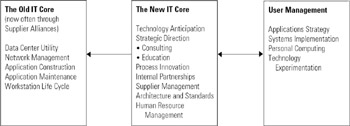The New Core IT Activities
While it is simple to describe the eight imperatives, putting everything in place to be effective in each area is much more difficult. Unfortunately, most IT organizations cannot succeed in all areas. Because of a lack of skills or just inadequate staff for all the IT-related efforts under way in most major organizations, outsourcing is increasing rapidly. In fact, most of the activities that the old IT organization once did—running the network, managing the utility, developing and maintaining systems, and managing workstations—can now move to an external vendor (see figure 14.4). What, if anything, are the current and future roles of the IT organization?

Figure 14.4: The New Core Activities for IT. Source:Adapted from J. Owens, "Transforming the Information Systems Organization", CISR Endicott House XXIX Presentation, 2–3 December 1993
No matter how many or how few of the old organizational activities are outsourced, the IT organization itself has shifted from being primarily a "doing" function to a more business-centered, advisory, and management function. In large organizations, IT management will increasingly see its new primary roles as: (1) ensuring that line managers at all levels understand IT's potential and how to use the IT resource most effectively in carrying out their strategies; and (2) providing advice and expertise to ensure effective implementation of the business strategies and tactics. In other words, IT management will work with line management to ensure that the business is doing the right things with information technology.
As a result, the IT organization's core responsibilities as we move toward the year 2000 will increasingly include understanding and interpreting technology trends; working with line managers to help them develop IT-enhanced strategies; educating and consulting with line management to ensure that the strategic direction is carried out; taking responsibility for, or supporting at the very least, effective process innovation; developing relationships that permit useful internal partnerships; managing suppliers to whom parts of IT have been outsourced; and developing and managing the IT human resource (see central box in figure 14.4). The old core IT activities, many of which are being subcontracted to the marketplace by outsourcing or joint ventures, are the "doing" activities; they may be retained in-house (insourced) but are managed very much as a commodity (see left-hand box in the figure). User-management responsibilities are both traditional—carrying ultimate responsibility for applications strategy and for systems implementation—and new— personal and local computing, and, increasingly, business-oriented experimentation with new technologies (see right-hand box).
Given this division of activities, IT management not only is responsible for the new IT core but also has to assist line and user management in managing IT activ ities. In addition, IT management has to ensure that the "old" tasks are efficiently and effectively carried out, either internally or externally. While both these concerns have always been part of the IT mission, too few organizations have successfully addressed the need for business-oriented IT personnel capable of building relationships necessary to work effectively with line managers and third parties. Today, this job is becoming the primary or "core" role of the IT organization.
EAN: 2147483647
Pages: 214